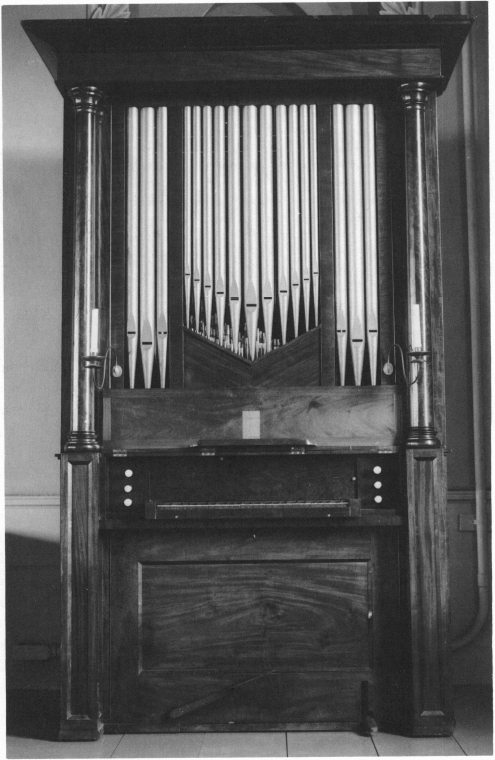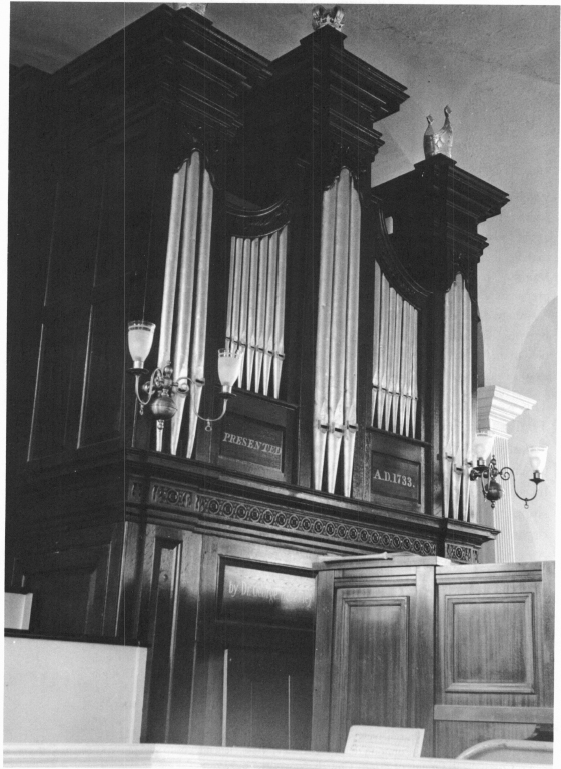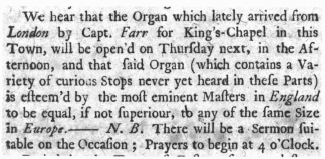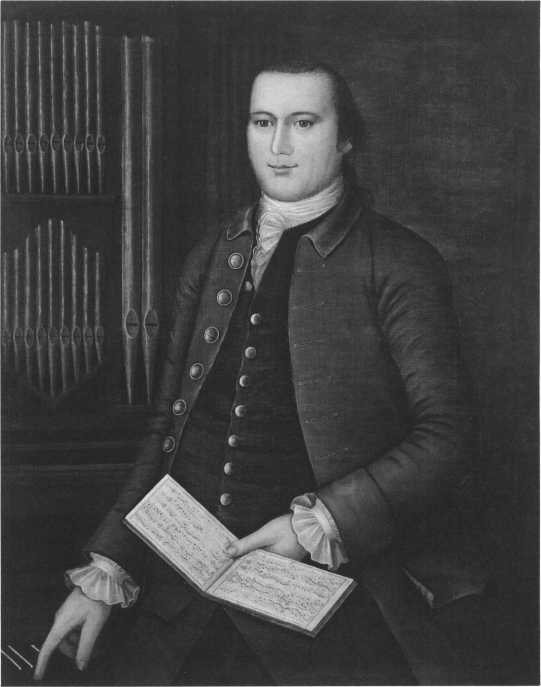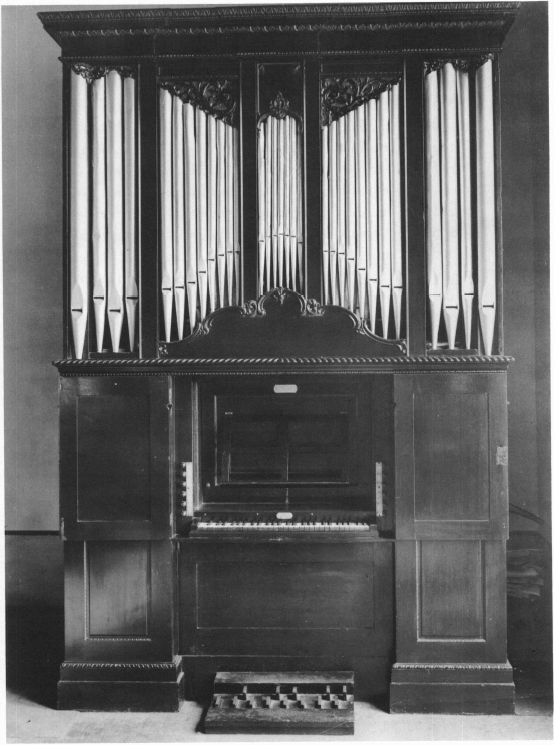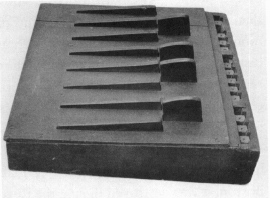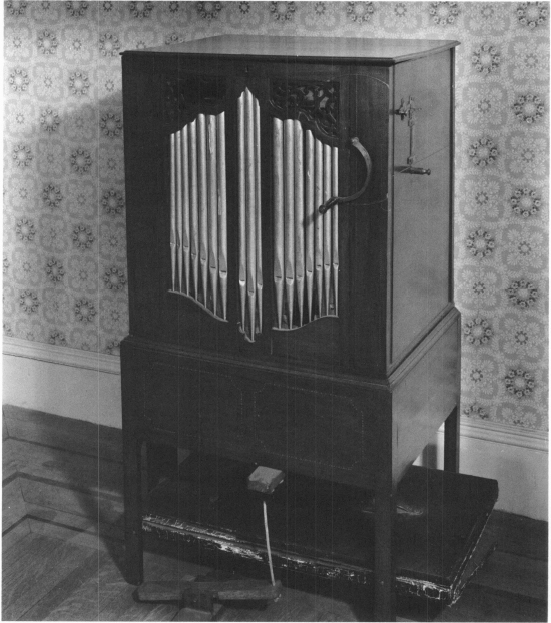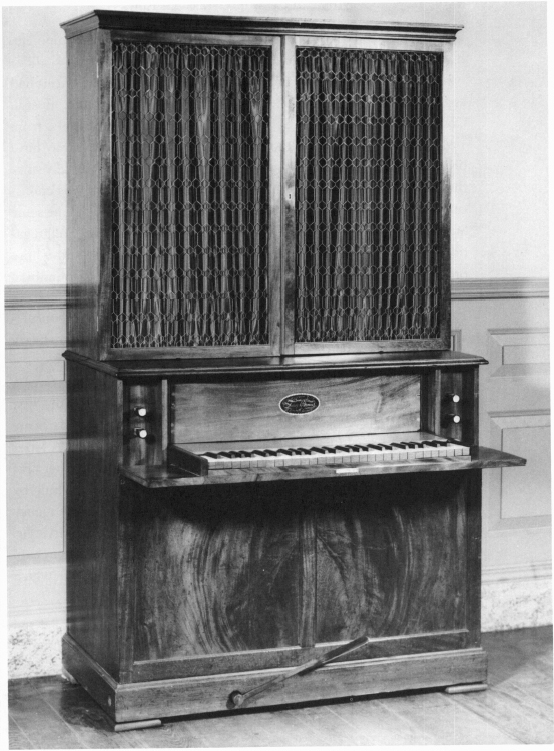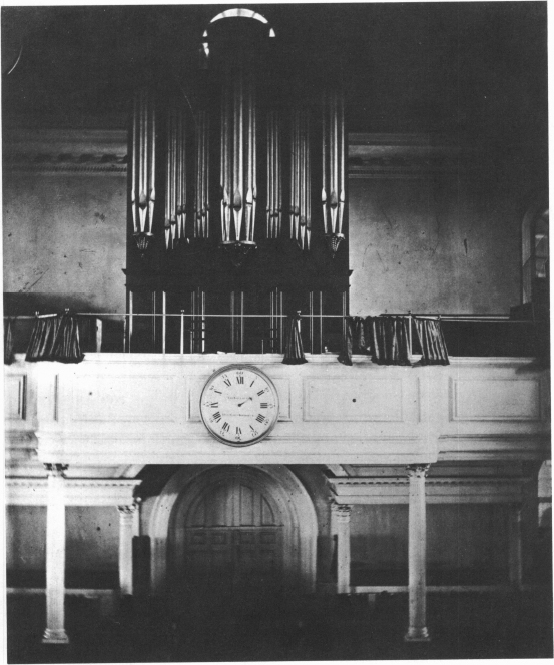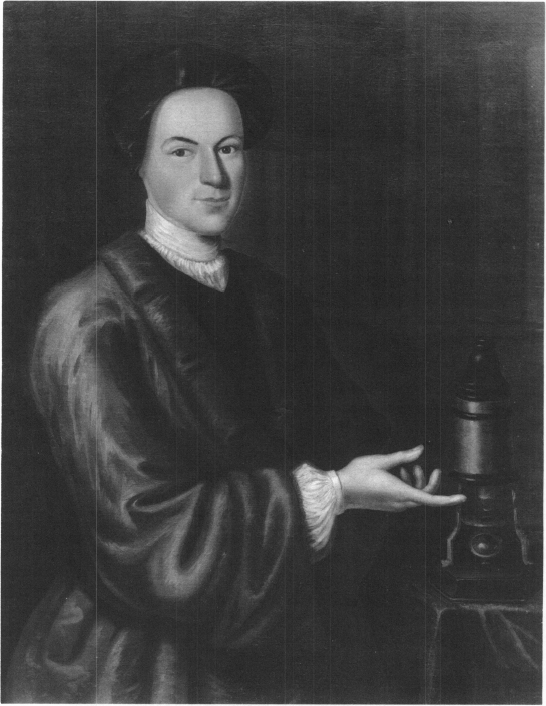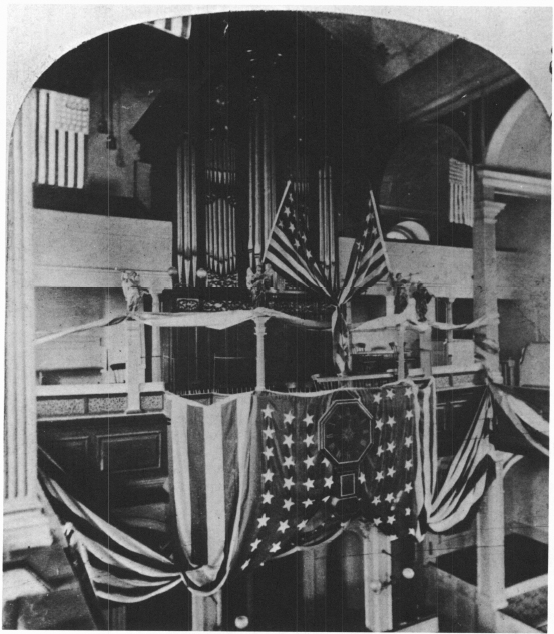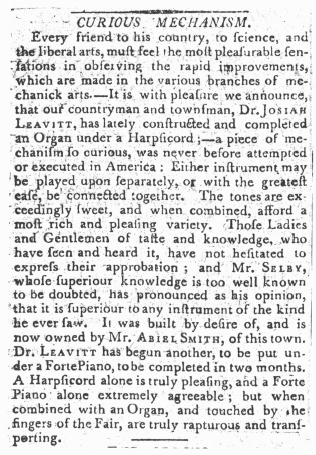Eighteenth-Century Organs and Organ Building in New England
THE first organs on the American continent were Spanish. During the first great flowering of Iberian culture in South and Central America, organs were both imported and built for the great cathedrals and churches of New Spain, which then included what are now the states of New Mexico, Arizona, Texas, and California. An organ is recorded as early as 1610 in Santa Fe, and there were barrel organs used in the California missions before 1700. In the more southern centers of New Spain instruments of considerable size and scope dating from the late seventeenth and the eighteenth centuries may still be found.
The beginnings of the organ in the east-coast colonies of North America were much more humble, however. Here the earliest date at which the use of an organ is recorded is 1703. In this year a group of German settlers known as the “Hermits of the Wissahickon” lent a small organ in their possession to the Gloria Dei Church in Philadelphia for the first Lutheran ordination ceremony to be conducted in the New World. This was a very small “positiv” type of organ which probably contained no more than three or four stops. When this little instrument first came to these shores is unknown, but in all likelihood it was brought over by these German colonists when they arrived in the latter part of the seventeenth century. It might be mentioned here that there is no foundation for the tradition that the Anglican Church in Port Royal, Virginia, imported an organ in 1700. Their own church records make no mention of an organ until 1771, and the organ possessed by the Smithsonian Institution, which long purported to be the mythical “1700” organ, has since been proven to have been built by an American builder in 1813 for a church in Alexandria, Virginia.
Although the liturgically oriented Lutherans and Anglicans may fairly be credited with the practical introduction of the organ to the thirteen original colonies, the first organ in Boston was introduced not by an Anglican, but by a Puritan. At the beginning of the eighteenth century Thomas Brattle, treasurer of Harvard College, a founder of the Brattle Square Church, and one of the leading citizens of Boston, had in his home a small English chamber organ of four stops1 in a handsomely carved oak case (fig. 352). In all likelihood it was the only such instrument in New England, and was enough of a curiosity to have been recorded by at least two diarists. In his diary entry for September 3, 1708, Chief Justice Samuel Sewall, referring to a room in which a funeral had been held, wrote, “I used to go to the same room for the sound of Mr. Brattle’s Organs.”2 On May 29, 1711, the Rev. Joseph Green recorded that he “was at Mr. Thomas Brattle’s, heard ye organs and saw strange things in a microscope.”3 It is evident from the first of these references that the organ was not new when Judge Sewall mentioned it. The question then arises as to just when Mr. Brattle acquired this little English chamber organ which was to become, upon his death, the first recorded church organ in New England. Thus far it has been a mystery which has defied solution, but a conjecture may be permitted. In 1689 Thomas Brattle made a trip to England. Born in the colonies, he had probably never seen an organ before this time, but he doubtless saw several in Restoration England, where the art of organ building was just beginning to recover from the blows dealt it by the Commonwealth, during which virtually all church organs had been ruthlessly destroyed and many organ builders forced to flee to the Continent. Brattle was a cultured man, interested in music and the arts. Did he, perhaps, fancy some small chamber organ seen in the home of a friend, and conceive the idea of owning one like it? Could he not have ordered one built for him during his stay, or purchased one already built? The answers to these questions we shall probably never know, yet it seems quite likely that, during this one visit to the Old World, Thomas Brattle decided that he would like to own an organ, and either brought one back to Boston with him on his return, or ordered one sent to him at some later date.
Fig. 352. Chamber organ (the “Brattle organ”) by an unknown maker, England, early eighteenth century.
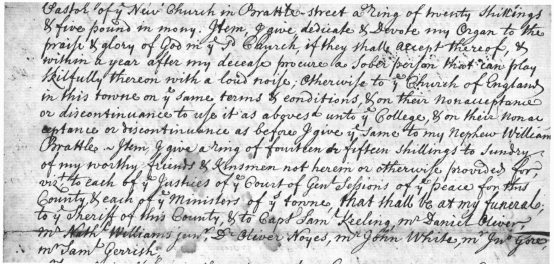
Fig. 353. Detail from the will of Thomas Brattle, Boston, 1713.
Just as the actual date of the first recorded organ in New England is unknown, so also is its maker. There is much folklore concerning it, and it has at various times been attributed to Renatus Harris or Bernard Smith, two of the leading London organ builders of the Restoration period, as well as to the obscure Preston of York. This small organ, still in existence,4 has been rebuilt and altered many times, but the wind-chest, wood pipes, and some of the metal pipes are original.5 During its restoration in 1965 by Charles B. Fisk of Gloucester, Massachusetts, great care was taken to examine all of these original parts for clues to the identity of the builder, but none were found.
Until Brattle’s death in 1713, this organ remained a house instrument, used for secular music and perhaps in private devotions, as seemed to be the custom of certain English Puritans. In Brattle’s will (fig. 353), however, he stipulated that the organ be given to the Brattle Square Church with the condition that within a year after his death a skillful organist be found to play it; otherwise the organ should go to King’s Chapel, on the same terms.
The Brattle Square Church was founded by some of the more liberal-minded Puritans as a protest against the, to them, increasingly ingrown religion of the Mathers and other old school divines, and was known as the “Manifesto Church” because of the document which its founders drew up to justify their withdrawal from the more conservative flock. Nonetheless it was still a Puritan church, and it would not be until 1790 that its members would discard the Matherian notion that the use of instrumental music in worship was an Old Testament practice which, since it is not specifically recommended in the New Testament, must be avoided by followers of the New Testament faith. Thus, the Brattle Square Church informed Thomas Brattle’s executors that “with all possible respect to the memory of [their] deceased Friend and Benefactor . . . they did not think it proper to use the same [the organ] in the publick worship of God.”6
Brattle was a remarkably broadminded man for his age. He had vigorously opposed the Salem witchcraft proceedings (of his part in which the pious Judge Bentley later publicly repented, and concerning which even the stern Cotton Mather finally admitted misgivings), and, at the end, had demohstrated the extent of his goodwill toward the abhorred Church of England by offering the organ to King’s Chapel if it was refused by his own church—even, it will be noted, in preference to Harvard College, of which he was treasurer. Thus, in the summer of 1713, King’s Chapel voted “that the Orgins [sic] be accepted by the Church, and that Mr. Miles answer Mr. William Brattle’s letter concerning same.”7 New England possessed its first church organ.
Had the Brattle Square Church broken the Puritan ice by accepting Thomas Brattle’s small organ, Boston’s native school of organ building might have begun its development a half century sooner. Another whole generation was to come and go, however, before any change in the old attitude would be felt. The idea that God was displeased with instrumental music in the worship service, even as an accompaniment to psalm-singing, died hard, especially when reinforced by threats, such as Cotton Mather’s, that this practice would lead to “. . . the imposition of all the Instruments used among the ancient Jews. . . . Yea, Dancing as well as Playing, and several other Judaic actions.” Mather’s authority for all this is a typical piece of twisted Puritan logic. Having combed the New Testament for some indication that instrumental music was used by the Apostles or the early Church and finding none, he concluded that God “rejects all He does not command in His worship” and “therefore, in effect, says to us, I will not hear the melody of thy organs.”8
The Anglican churches were, of course, unaffected by Puritan taboos, and, during the course of the eighteenth century, imported organs from the Mother Country as fast as they could afford them. Thomas Brattle and other liberals had obviously started the Puritans thinking, however, and they spent most of the rest of the eighteenth century arguing the pros and cons of instrumental music in their worship. The volume of verbiage expended on this subject is, indeed, rather remarkable. Harvard students wrote papers on it and discussed it at their Commencements; eminent and not-so-eminent divines preached sermons and published tracts on it. Tempers waxed hot on occasions, and stubborn church members marched righteously out of the service when their minister took a position opposite to theirs. In the latter half of the eighteenth century an unidentified English gentleman offered £500 to any Puritan church which would obtain an organ and use it in their worship, but when the Brattle Square Church finally did decide to get an organ late in the century, one of its members, according to tradition, offered to give a sum equal to its price to the poor for the privilege of depositing the organ in Boston Harbor. Around the same time the First Church made up its mind that it too ought to have an organ, and solicited funds from some of its wealthier members. One of these, instead of donating the suggested sum, used it to finance the publication of an anti-organ tract.9
Most of the larger city churches, when they began to think in terms of instrumental music, were thinking in terms of an organ. The matter was somewhat different in the small city churches and the rural churches. Many could not afford an organ, and even if they could there was no guarantee that anyone could be found to play it. Still, like their larger city brethren, many of these smaller churches began to aspire toward instrumental music, especially since it offered some hope of raising the congregational singing from the low level to which it had fallen during the first century-and-a-half of New England’s existence.
A discussion of the practice of psalmody in the colonies is outside the scope of this paper except as it directly affected the introduction of organs into New England churches. It may be briefly stated that, it having sunk to so low a state as to prompt impassioned tracts and sermons from the more sensitive among the clergy and laity, two avenues of reform gradually began to develop in the latter half of the eighteenth century. One of these was the introduction of instrumental assistance. The other, favored no doubt by those who still harbored doctrinal prejudice against the use of instruments in worship, was the singing school. Many reformers backed both approaches, and indeed, by the time the reform was accomplished in the early decades of the nineteenth century, the two avenues had become a single thoroughfare. Although the earliest collections published for the use of singing schools were clearly meant for unaccompanied singing, accompaniments for certain pieces are found as early as 1804 in the Bridgewater Collection, followed in 1807 by the Hartford Collection and Newburyport Collection. From this time on, pieces with instrumental accompaniments or interludes are frequently encountered in songbooks, even where the bulk of the contents are still intended for unaccompanied singing.
As previously stated, not all churches introduced instrumental music via the organ. Particularly in rural areas, the first instrument used to aid congregational singing was the bass viol, or the so-called “church bass,” colloquially known as “God’s fiddle” (to distinguish it from “the Devil’s fiddle,” or violin, commonly used in secular entertainment in this period). The bass viol had three to five strings, and its size was somewhere between the modern violoncello and bass viola da gamba. The first bass viols were imported, but soon were being made in quantity in Boston. By the turn of the century, New Hampshire had become a center for the making of these instruments. It was a convenient instrument for many small churches—portable, relatively unobtrusive, and easily learned by any amateur with a musical bent. Many churches later added other instruments—German flute, clarinet, violin, bassoon, cornet, ophicleide, trombone; whatever was handy—and the church band was born. The next step, sometimes not taken until well into the nineteenth century, was an organ. But by then any reservations against “worshipping God by machinery” had quietly died, and the introduction of the organ was hailed as an auspicious event.
While musical education had begun and instruments were beginning to find acceptance in churches of other than Anglican tradition by the middle and late eighteenth century, the beginning of a native school of organ building was still some years in the future. Its foundations were being laid, however, by the prospering Anglican churches. The first such church to have an organ was the previously mentioned King’s Chapel of Boston, which inherited Thomas Brattle’s four-stop chamber organ in 1713. Twenty years later the first organ actually designed for church use made its appearance in Newport, Rhode Island. In 1724 Trinity Church of that town erected a handsome wooden building, which still stands in virtually original condition. To Newport, and to Trinity Church, came Dr. George Berkeley in 1729. Dr. Berkeley, a noted philosopher and later Bishop of Cloyne in Ireland, built a house in Middletown, just north of Newport, where he remained until 1731. He enjoyed his stay in Rhode Island, and made warm friends in Trinity Church. Being a man of some considerable wealth, he determined on his return to his homeland to send a gift to the church whose fellowship he had enjoyed in the New World. This took the form of a small two-manual organ built by Richard Bridge (fig. 354), which arrived and was set up in 1733.10
William King Covell unearthed several items pertinent to the Bridge organ in the records of Trinity Church. This instrument apparently arrived early in 1733, for on February 25 of that year it was
Voted: that the Church Wardens write to Mr. Charles Theodore Perchival, in Boston, to acquaint him that the organ is arrived for the Church, and that he is desired to come up here and assist us with his advice, in putting the same up, and that he shall be satisfied for his assistance in the affair. Also to Mr. Richard Munday, to desire him to come here forthwith, to advise and assist us in preparing a plan to set up the organ in the Church. The Rev. Mr. Honyman is desired to draw a letter of thanks to the Rev. Mr. Dean Berkeley, for his generous present of an organ in this Church, and likewise a letter of thanks to Mr. Henry Newman, for his care about and shipping the same, in order to be sent to England as soon as conveniently may be.11
This would certainly seem to confirm that the organ was sent directly to Trinity Church by Dean Berkeley. Charles Theodore Perchival was actually Karl Theodor Pachelbel, son of the German organist and composer Johann Pachelbel. Henry Newman was the counsel for the Province of Massachusetts in London who apparently handled the details of shipping the organ from England. The handsome oak case of the Bridge organ has the distinction of being the oldest surviving English case in America although it has housed several later organs and has had wings added to the sides, not visible in figure 354.
In the church records Mr. Covell also found some correspondence with Richard Bridge dating from 1755, in which some dissatisfaction is expressed with one of the original stops of the organ, possibly a reed stop. The pipes of this stop were returned to Bridge with instructions to either improve them or replace them with another stop,12 but the outcome of this matter is not known.
Fig. 354a. Organ case by Richard Bridge, London, 1733, in situ in Trinity Church, Newport, Rhode Island.
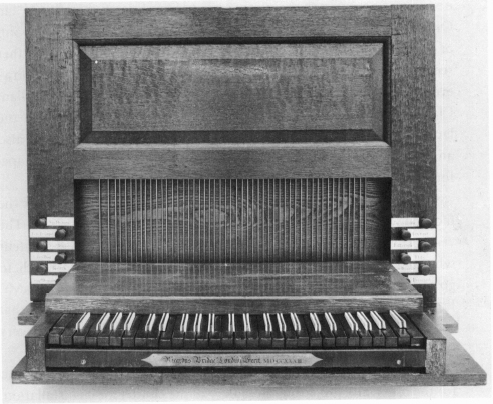
Fig. 354b. Original keyboard from the Bridge organ, 1733.
Shortly after the arrival of the Richard Bridge organ in Newport, two more organs appeared in Boston, the first in any churches since King’s Chapel acquired Thomas Brattle’s chamber organ over two decades previously. In 1723 Christ Church in the North End, a daughter church of King’s Chapel, erected that delicate jewel of a building which still graces the North End of Boston. For thirteen years it had no organ, although inquiries were made as early as 1734 into the possibility of obtaining one. In 1735 the vestry seriously considered the offer of “an Organ with eight stops or more” by a party in Philadelphia, to the point of starting a subscription to raise the money to buy it.13 Nothing further seems to have been done with regard to the Philadelphia organ, however, and in August of 1736 William Price received a letter from William Claggett of Newport, Rhode Island, concerning an organ which the latter had for sale.14 Price, although a merchant by profession, was also an amateur musician, and had played the Brattle organ at King’s Chapel for a year prior to the advent of Edward Enstone from London.
Claggett’s organ was of definite interest to Christ Church, despite the fact that they tried to haggle down the price from £400 to £300. The vestry empowered Price and Stephen Deblois, another musical amateur who later played the organs in both King’s Chapel and Christ Church, to go to Newport to inspect the instrument at the church’s expense. Mr. Price alone went to Newport, in September of 1736, reporting back that “said Organ is readily worth the money demanded for the same and very suitable for our Church.”15
The vestry acted on Price’s recommendation, paying Claggett £320 for the organ and preparing the gallery of the church for its installation. Claggett himself installed the instrument in late October, and it was used in a service for the first time early in December of 1736, the organist being William Price. There are several curious things about this organ. Apparently it either had no case, or its original case did not suit the church, for in April of 1737 Price submitted a bill (which he actually paid himself as his contribution to the organ) for “projecting and drawing a draft of ye Organ” (i.e., the organ case), “directing ye workmen to making it” and “drawing 6 large Pennels [sic] of Cut Work. . . . Ditto 6 smaller.”16 It would seem also that the organ was a rather poor and defective one, for beginning in 1743 and recurring repeatedly in the church records from then on are payments to Thomas Johnston, James Buck, and a Mr. Halliburton for altering and repairing Claggett’s organ.
Unfortunately, no description of this organ exists, and it is not known whether it had one manual or two. A far greater mystery, however, is the question of who actually made it. The previously mentioned fact of its constant need for repairs could indicate one of two things: that it was, when purchased, already an old organ; or, that it was a somewhat amateurish creation of Claggett himself. The fact that it apparently had no outer case when purchased might point to the latter assumption—unless, of course, its original case was so simple that the church felt a more elaborate one was needed. Our knowledge of Claggett throws little further light on the matter of whether or not he was the actual builder of Christ Church’s organ—which would, indeed, have made him the first organ builder in New England. He is believed to have been born in Wales in 1696, came to Boston some time prior to 1714, when he married Mary Armstrong of that city, and moved to Newport in 1716. His primary occupation was that of clockmaker, and he is referred to by clock historians as being “among the earliest builders of fine clocks in America,” along with Benjamin Bagnall of Boston and Peter Stretch of Philadelphia.17 That he was a clockmaker should in itself be enough to establish him as a man of considerable mechanical skill, but he was also a dabbler in the then novel science of electricity, and, as an engraver, he printed paper money for Rhode Island in 1738. He made at least one large and elegant clock with a movement of ten bells which played two current English ditties, and one writer cites an unidentified 1725 source as referring to him as a “musical instrument maker,”18 but none of these facts is really sufficient to establish him as an organ builder. Indeed, the organ which was sold to Christ Church is the only musical instrument of which there is any record in connection with William Claggett.
There is one fact, or perhaps absence of fact, which inveighs rather strongly against the possibility of Claggett’s having been an organ builder, however. A great many references have been found to the repairing, altering, and tuning of the organs in Christ Church, Boston, and in Trinity Church, Newport, where Claggett lived from 1716 to his death in 1749. It is true that he did indeed set up the organ which he sold to Christ Church, but this is the first and last record of his having done anything whatever to it, all subsequent tuning and repairs having been executed by a variety of other persons. What is much more pertinent, however, is that when Trinity Church in Newport received Dean Berkeley’s gift in 1733, individuals from Boston had to be asked to set up this organ. This was only three years prior to the sale of Claggett’s organ to Christ Church, and he was at that time a well-known figure in Newport. Surely if he were an organ builder the members of Trinity Church would have known of it, even though, being a Baptist, he had no distinct connection with that church. Even assuming that the Christ Church organ was the first which he had built, it is likely that thereafter he would have been asked to at least tune Trinity Church’s organ. But instead, in the vestry’s letter to Richard Bridge in 1755 (only six years after Claggett’s death) this revealing passage appears: “We waited so long in hopes an organ builder might accidentally come here, but as there is no one expected now, we hope for the credit of your organ, you’ll repair this to your satisfaction . . . ,”19 This letter was written, as may be recalled, concerning the unidentified set of pipes which had never worked properly since the organ was installed in 1733. Indeed, although Bridge sent another organ to the colonies in 1756 (for King’s Chapel), and requests for a new stop to replace the defective one were made again in 1769, 1770, and 1774, there is no indication that the church’s desires in this matter were ever satisfied. The church was so insistent in its attempts to rectify this defect in the Bridge organ that it seems hard to believe that it would have overlooked a local organ builder had one in fact existed, no matter how rank an amateur he might have been. In view of this, it seems more likely that the organ which Claggett sold to Christ Church in 1736 was either one which he had imported from England for such a purpose or, quite possibly, a chamber organ which he had had for his own use and for some reason decided to dispose of. Considering the station in life which he occupied as a successful artisan in a prospering seaport community, this latter assumption—while it must remain an assumption for want of better proof—seems much more likely than the assumption that, in a time and place where information on the art was severely limited, he was the actual builder of the Christ Church organ.
In April of 1734 the cornerstone was laid for the third Anglican church to be founded in Boston. This was Trinity Church, serving parishioners in the then newly settled southwest corner of the town. The building was completed in 1735, and although some sources state that it possessed an organ as early as 1736 or 1737, the church records are silent with regard to organs until 1744. In November of that year a two-manual instrument built by Abraham Jordan of London arrived in the port of Boston on the good ship Swan, destined for Trinity Church. With this organ came detailed directions for setting it up, which are preserved in the church’s archives.20 So detailed, indeed, are these directions, that a great deal of information about the contents and appearance of the organ can be gleaned from them.
This first two-manual organ in Boston—possibly the first actually built expressly as a church organ—contained thirteen stops and had, of course, no pedals. The main case was in five sections, three towers and two flats, the flats being surmounted by decorations in the form of gilded urns and the towers having gilded pipe shades. The keydesk was attached to the main case and enclosed by doors. In addition, there was a chaire (ruckpositiv) division on the gallery rail, resembling the main case, but smaller in size. The treble portion of the chaire pipework was enclosed in a primitive “guillotine”-type swellbox, basically an “echo” box with an opening covered by a vertically sliding panel controlled by the player’s foot. It must be remembered in this context that Jordan was claimed as the inventor of the swellbox, having first introduced such a device in his organ for St. Magnus Martyr Church in London, built in 1712. Although a similar mechanism had been in use at an earlier date by the Portuguese, Jordan, if not actually the inventor (or reinventor), does indeed seem to have been the first to have introduced the idea to England.
The organ was blown by two diagonal bellows weighted with forty-four pounds each. The case was of fair size, the width of it being 10 feet 2 inches, the depth 6 feet 9½ inches, and the height to the impost 7 feet 7 inches. As the portion of the case above the impost is usually somewhat taller in proportion to the part below, the total height of this case was probably something in the vicinity of from 15 feet to 17 feet.
To the directions Jordan appended a little testimonial, giving locations of some of his recent work in England, and stated that the Trinity organ, while in his workshop, was tried and approved by “Mr. Hendall our great Master”—undoubtedly Georg Frederic Handel—as well as John Robinson, organist of St. Martin’s-in-the-Fields, London. “They all allow & say yours is as good an Instrument for wt it contains as ever went out of England,” stated Mr. Jordan. The organ cost £300, which, added to the shipping costs, brought the total paid by the church to £362.3.7.
The organ was probably set up by people having little experience with that sort of work, and thus Jordan included a “tunning brass” (tuning cone) with instructions to tune the organ to the bass of the stopped diapason. One hopes that the stoppers in these pipes did not change their position much with the jarring of their long ocean voyage! Jordan also gave optimistic advice on the alleviating of cyphers (notes which sound when they shouldn’t): “if a key speaks without touching,” he said, “then open or unscrew the Foreboard and take a goose feather and brush ye pallet & all will be right.”
That the organ presented a pleasing aspect in the church is attested to by an entry in the journal of Capt. Goelet, a visitor to Boston, who heard the organ on October 14, 1750, shortly after its installation:
This Build is very Plain without, with Large Sash Windows, But within Verry Neat and Comodius, the Architect Modren, with a Very Neat Little Oargan Pretily Embelished, this Church havg no Steeple Looks more Like a Prespetarian Meeting House.21
Early in the nineteenth century the organ seems to have fallen into a poor state of repair. The then organist, Peter Albrecht van Hagen (1781–1837), who occupied the position at Trinity Church from 1801 to 1809, saw fit to discuss the matter in some detail in a letter (unfortunately undated) found in the church records. Most of the troubles seemed to be the “Common Case with an Organ which is getting old,” as van Hagen put it—moth-eaten felts, cracked bellows leather, sticking keys, oxidation of pipe metal, “Verdegrease” on reed tongues, leaks, and rattles. The petition ends with a request for the addition of pedals to the organ and a raise in salary for the organist.22 Apparently van Hagen’s plea was not in vain, for in 1808 the Jordan organ was repaired by William Goodrich (1777–1833).23
In 1829 the church erected a new granite edifice, to which the old organ was moved. No further description of it is found until 1834, however, when an anonymous writer in New-England Magazine gave the following description, supplied by “a gentleman amateur, the son of a former rector.”
It is of moderate size, with two rows of keys, and consists of a great organ and swell. When played full, it has good body of tone, and all the stops mix well. But the solo stops, played as such, are not good, especially the reeds. The organ was put up again in the new edifice, where it still remains; but it is altogether insufficient in power, as well as in variety and excellence, for Trinity Church.24
The 1834 article also suggests that the organ was secondhand, and came from Salisbury Cathedral or some other Salisbury church. The previously mentioned description in the church records would seem to negate this suggestion, however, as does the fact that Salisbury Cathedral erected a splendid four-manual organ by Harris in 1710, which was still in use in 1744. In addition, research by a Salisbury historian, Miss Betty Matthews, fails to discover any local church which might have sold an old organ between 1735 and 1745.25
The Jordan organ remained in use until another English instrument was purchased in 1837. It is said to have been sent to a church in Pittsfield, but has long since vanished.
North of Boston, the thriving seaport town of Salem was rivaling its neighbors in growth and wealth. St. Peter’s Church in that town had recently put up a new building, and, feeling the need of an organ for their new structure, its members began to take up a subscription for one. Thus, in 1743, “John Clarke, Esq., imported an organ for the church, the first to be set up in the town, and John Young was engaged to put it in place. The cost of the Organ was £382, a generous part of which was paid by Mr. Clarke.”26 The church minutes for October 5, 1743, put it more succinctly: “Voted, that Capt. John Clark have leave to put up his organ in St. Peter’s Church.”27 Little else is known about this organ, probably a chamber organ, which was replaced in 1754 by one built by Thomas Johnston of Boston.28
Of all the organs mentioned thus far, at least two had two keyboards, but the first three-manual organ of which there is any record in a New England church was built in 1756 by Richard Bridge of London for King’s Chapel (see fig. 354), replacing the over-fifty-year-old Brattle organ, which was sold to St. Paul’s Church in Newburyport. This Bridge organ was the first of three English instruments destined to have a profound influence on Boston organ building in the next fifty years.
Richard Bridge was one of the more notable eighteenth-century English organ builders. Said to have been trained by John Harris, and a contemporary of John Byfield, his case designs and tonal work were firmly rooted in the turn-of-the-century tradition established by Renatus Harris. As noted, Bridge had already built one organ for an American church—Dean Berkeley’s gift to Trinity Church in Newport—and for many years it was thought to have been his only instrument in the colonies, due to a persistent but erroneous legend originating some time in the nineteenth century to the effect that the builder of the King’s Chapel organ was one Adrian or Adam Smith. Not only are British organ historians unable to identify any builder of this name, but the records of King’s Chapel contain the letter written to the church officers of June 15, 1756, from Thomlinson, Trecothick, and Company of London, the agents commissioned to procure the organ, here quoted in full:
London, 15th June, 1756
Gentṣ,—We have at length the Pleasure of inclosing your Invoice Bill of Lading for your Organ, wc̣ḥ s ship’d on board the “Beaver,” Capṭ Farr, and cost £571.12s.2d—it has been very thoroughly tried by Mr. Stanley and several other of the most noted Organists who agree in pronouncing it a fine toned, compleat Instrument.—we have no other fear about it than that of its meeting an Accident on its way to you.
Inclosed are some directions from Mr. Bridges; also a Certificate from some of the Gentṣ who have tried it.—the Alteration made was judged quite necessary, and indeed Mr. Stanley is of the Opinion that it would have been as compleat, altho’ some other parts of the Direction had been disregarded.
Mr. Bridges has found it a very hard bargain; and to enable him to carry it thro, we have been obliged to advance him part of the money some time ago, and to pay him the whole remainder on delivery.29
This letter, incidentally, also debunks another popular myth concerning the 1756 King’s Chapel organ which holds that it was selected or approved by Handel. From the above it will be seen that it was not Handel but the blind John Stanley, organist of London’s Temple Church, who judged and approved the organ.
Fig. 355. Announcement from the Boston Gazette, August 30, 1756.
The organ arrived early in August of 1756, and notice later appeared in the Boston Gazette for August 30, 1756 (fig. 355). Thomas Dipper, a professional musician from England, was brought to Boston to play the new Bridge organ, and from that time on King’s Chapel has held a prominent position of leadership in the musical life of Boston.
In 1771 or 1772 William Selby, another English musician and a composer of some accomplishment whose works were published in both London and Boston, came to King’s Chapel. After a brief term as organist of Trinity Church, Newport, Rhode Island, Selby returned to Boston in 1776 or 1777 to resume his post at King’s Chapel and to become a leading figure in Boston’s musical life (fig. 356).30
One of the earliest concerts of sacred music in New England history was given in King’s Chapel by Selby in 1786, containing vocal, choral, and instrumental works in addition to an unidentified organ solo.31 A similar concert was given in King’s Chapel in 1812 by George K. Jackson, another English-trained musician, and in 1815 it was the scene of the first performance of the newly formed Handel and Haydn Society.
Fig. 356. Portrait of Peter Farrington by an unknown artist, United States, 1781.
The earliest known description of the Bridge organ of 1756 dates from 1834 and, because of its critical comments, it is worthy of quotation in full:
The late Dr. G. K. Jackson declared this organ to be the best he had ever touched in America. Its chorus stops are, however, very numerous and powerful, compared with the fundamental stops. The great organ has, in addition to the stopt diapason, only one open diapason and trumpet; yet, besides the principal, twelfth, fifteenth and tierce (or seventeenth), there are a cornet of four ranks, and a sesquialter of four ranks. This multiplication of the harmonics, especially the seventeenths, with a diapason so comparatively feeble, renders this organ, when played full, too harsh and discordant. It is therefore seldom played full; and, when managed by an organist possessing good taste as well as skill, it is probably superior in effect, though not in power, to any organ in New-England. It has a great organ, choir organ, and swell, with three rows of keys. The long keys are black, the short keys white, contrary to what is usual. The choir organ contains a vox-humana stop, the only one, probably, in North-America; but it has no open diapason or dulciana. The stops are by no means numerous, there being only nineteen or twenty in all the three organs. The number of pipes, however, owing to the many small ones contained in the eight ranks of the cornet and sesquialter, is 1330. Dr. G. K. Jackson thought, that the full organ was deficient in the bass; and in consequence, a sub-bass was added, in 1825, by Mr. Goodrich. . . .32
This organ remained in use with little alteration until 1860, when it was rebuilt by the Boston firm of Simmons & Willcox. At this time, parts of the Bridge organ not used in the rebuild, including two of the wind-chests and several sets of pipes, were incorporated into a new organ for the Methodist Church of Schuylerville, New York. The King’s Chapel organ was again rebuilt in 1884 by Hook & Hastings, still retaining of some of the original stops. In 1909, however, an entirely new organ was installed. The only parts of the Bridge organ now remaining in King’s Chapel are the pipe shades, cherub heads, crown, mitres, cartouches, and other carvings from the original case, the present case being, with these exceptions, a reproduction of the original one (fig. 357).
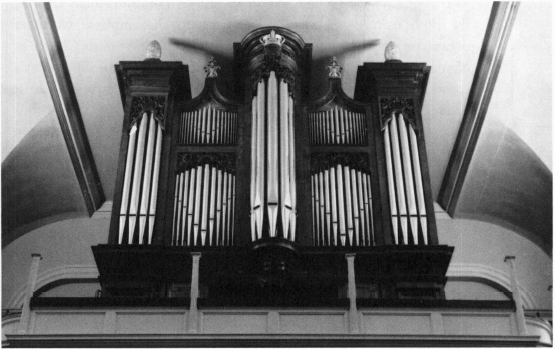
Fig. 357. Organ by Richard Bridge, London, 1756, in situ in King’s Chapel, Boston.
From the time of the importation of the King’s Chapel organ in 1756 to the end of the century, church and chamber organs were imported from old to New England in rapidly increasing numbers, although the former were almost always for Anglican (Episcopal) churches. Except for certain other organs which, like the organ of King’s Chapel, exerted a discernible influence on the early organ builders of Boston, it is not necessary for the purposes of this study to go into great detail regarding many of these.
Until the 1750s there were no organs known of outside the Boston area, but in 1755 or 1756 Christ Church in Stratford, Connecticut, imported an English organ through the agency of the Deblois family in Boston, and in 1759 or 1760 Capt. Richard Alsop donated an English organ to Christ (now Trinity) Church in Middletown, Connecticut. After the Revolution this organ was referred to as the “Crown and Mitre” organ because (like the organs in Newport and King’s Chapel) the top of its case was adorned with those royalist emblems. No other organs are recorded in Connecticut until 1785, when Trinity Church in New Haven purchased an organ from Henry Holland of London at a cost of £157. A few years later, in 1791, an organ was obtained by Christ Church in Norwich, Connecticut.
Boston’s neighboring town of Cambridge acquired its first organ in 1764. This was a two-manual instrument built by John Snetzler and obtained through the interest of Barlow Trecothick, Lord Mayor of London. Like others in the Boston area, it suffered damage during the Revolution, and a description of its condition is found in a contemporary letter describing a service which General George Washington attended on New Year’s Day, 1776:
Unfortunately the organ could not be used. Some of the leaden pipes had been taken out to furnish ammunition for our men at the fight in Charlestown last June, and it was quite out of order, but a bass viola and clarionet played by some musical soldiers led the singing which was very good.33
Another Snetzler organ came to New England two years earlier than the Cambridge one, but, considerable research notwithstanding, its original location has not yet been discovered. It made its appearance in the little Congregational Church of South Dennis on Cape Cod in 1858 (fig. 358) and has resided there, in regular use, ever since. The church records are vague concerning its origin and local tradition adds little. Some sources say it originally came from Providence; others say somewhere in Connecticut. Possibly it was in more than one church before coming to South Dennis, but the instrument itself offers no information save the little slip of paper pasted inside its windchest signed and dated by John Snetzler, London, 1762. While it has suffered some alterations during the nineteenth century, probably at the time of its moving in 1858, it is an important instrument in that, of all the larger English organs imported to New England during the eighteenth century, it is the only one to survive in reasonably original condition.
Fig. 358. Chamber organ by John Snetzler, London, 1762, now in the Congregational Church, South Dennis, Massachusetts.
While there were a few English organs of three manuals, and more of two (or, more correctly, one-and-a-half, since the upper manual was almost always incomplete with a compass which began only at G below middle C), the majority of these eighteenth-century imports had but one manual, and the South Dennis organ is therefore typical of these. While there is the possibility that it was originally used as a chamber organ (which would be one explanation of why its early history is so difficult to trace), it nonetheless has all that is needful for a church organ of its period, and, indeed, the organ builders themselves seemed to discriminate little between chamber organs and small church organs in the eighteenth century, regarding both tonal design and case design. The South Dennis Snetzler has the divided stops common in English organs of the day, and it is possible because of this to play much of the eighteenth-century English organ literature on it, including certain of the cornet voluntaries. It also has a thirteen-note coupled pedalboard which is apparently original, and quite unusual in a pre-1800 English organ of any size. The King’s Chapel organ, built only six years earlier and having three manuals, had no pedal keyboard until one was added in the nineteenth century; this was true of other larger organs as well, including most of those built for some years after 1762. Snetzler’s organ in Christ Church, Cambridge, however, might have had a pedalboard, for some years ago a thirteen-note box-type pedalboard very similar to that on the South Dennis organ was found among some other old organ parts in the cellar of Christ Church (fig. 359). The other parts were unfortunately destroyed, and were never identified.
As the colonies prospered, chamber organs began to appear in the homes of the more cultured merchants of New England. Since record of such organs has survived only in isolated instances, particularly in cases where, like Brattle’s, they were given to a church, there is no way of even estimating how numerous they might have been. As early as 1756 the household inventory of the estate of Addington Davenport iii, the son of the first rector of Trinity Church in Boston, recorded an organ.34
Fig. 359. Pedalboard probably from the 1764 Snetzler organ, found in cellar of Christ Church, Cambridge, Massachusetts.
Some time prior to 1798 (possibly as early as 1785, when Dr. Chauncy, the pastor, began to agitate for one), the First, or “Old Brick,” Church of Boston acquired a chamber organ by Jonas Ley of London (date unknown) which was large enough to contain a reed stop (hautboy). By 1834 the First Church had purchased a larger English organ, but the old chamber organ was still doing duty in the Episcopal Church of Dedham, having gotten there by way of the First Church in Dorchester. It has long since disappeared. Prior to 1800 the New South Church in Boston likewise acquired an English chamber organ which had originally belonged to a Mr. N. Frazier.
Without doubt the most famous and influential of these chamber organs which found their way into churches, at least since the Brattle organ, was that acquired in 1770 by the First Congregational Church in Providence. For, as Brattle’s instrument had been the first to sound in any Anglican church in New England, so this chamber organ, thought to have been the properly of merchant Jonathan Badger, was the first to enter the doors of a Congregational church. The Rev. Dr. Ezra Stiles, pastor of the Congregational Church in Newport, records in his diary on July 10, 1770, that “an Organ of 200 Pipes” was rather surreptitiously placed in the church without the knowledge of the congregation.35 Benjamin West, a local musician and member of the church, spent a month preparing for his first service as organist of the church, but history is distressingly blank as far as the outcome of that service and the reaction of the congregation are concerned. Indeed, the records of the church itself make no mention of the organ or its fate. It is Dr. Stiles who records its somewhat stealthy entrance, and who likewise records its similarly mysterious exit by noting on May 16, 1785, that “the small house Organ . . . is now gone.”36 Possibly, like some of the organs in Boston, it was destroyed during the Revolution, its pipes melted up for bullets. As the first church organ in Providence, however, it did have an immediate and lasting consequence in that the Anglicans, apparently taken by surprise by their Congregational neighbors, promptly acquired an organ for themselves in 1772—from the Deblois Concert Hall in Boston—illustrating how little the difference between the organs devoted to secular and sacred uses in the eighteenth century.
No organs are known to have made their appearance in the three northern New England states until the last decade of the eighteenth century. These were without exception small instruments of the chamber-organ type, and while a few of them were probably English, a large number were among the first fruits of the native school of organ building. The first church organ of any consequence in the northern states was that built by Thomas Elliot for St. John’s Church, Portsmouth, New Hampshire, in 1807, replacing a smaller instrument by Johnston destroyed in a fire. Although no description of it has been found, part of the casework still exists, showing it to have been a reasonably good-sized instrument, probably of two manuals, which Dr. Oliver of Salem professed to have “much admired.”37 It existed in regular use until 1914. The Second Congregational Church in Portland, Maine, acquired an organ in 1798, but it could not have been of much importance, since it was replaced not long after by one of local manufacture. The state of Vermont is not known to have contained any organs until the early nineteenth century.
Most of the owners of chamber organs in the eighteenth (and early nineteenth) century were cultured members of the well-to-do merchant class in New England. Many of these men, and members of their families, were proficient in music as amateurs, and often owned harpsichords or fortepianos as well. Even those who had not the time nor talent to master the instrument could enjoy the small barrel organs which became plentiful in this period. Advertisements for these precursors of the phonograph are frequently encountered in newspapers around the turn of the century and, while many were imported from England, some, especially after 1800, were domestic products. A few are preserved in museums and in historic houses such as the Jay Mansion in Bedford, New York, and the Black House, Ellsworth, Maine.
A barrel organ (fig. 360), presumably destined for some royalist’s home, was captured from a British vessel in 1780 by Capt. John Somes of Gloucester, Massachusetts, and given by him to the Independent Christian Church (First Universalist Society in America) of that city. The church resourcefully supplemented its two barrels of secular tunes with a barrel of hymns, and used it until 1802—one of the first organs used in any non-Anglican church in the colonies, and perhaps the first barrel so used. It still exists, unplayable, in the church’s historical collection.
Some professional musicians also owned chamber organs in this period. As early as 1801 singing master and carpenter Oliver Holden of Charlestown (see Crawford, p. 619 and fig. 340), the composer of the still popular hymn tune Coronation, owned a small chamber organ by Astor & Company of London, preserved today by the Bostonian Society in Boston’s Old State House, and restored by Douglas Brown of Groton, Massachusetts (fig. 361).38 Dr. George K. Jackson owned a large chamber organ which was sold to a man named Snowdon or Sowdon upon his death in 1823, and the ultimate fate of which is unknown.
Fig. 360. Barrel organ by Longman and Co., third quarter of the eighteenth century.
Fig. 361. Chamber organ by Astor and Co., London, ca. 1801.
In 1763 the first organ of any consequence to be used in a concert hall appeared. This was a Snetzler organ which was used in the Boston Concert Hall on Hanover Street, managed by Stephen Deblois, from 1763 to 1774. Nothing is known of it after this date, and it may have been, like many other organs, a victim of the Revolution, especially since the Deblois family were loyalists, much of whose property was confiscated. It is possible, although presently unprovable, that this is the same Snetzler organ, previously alluded to, which has stood in the Congregational Church of South Dennis on Cape Cod since 1858, and whose previous whereabouts are unknown. A place called the Columbian Museum in Boston had what was described as a “concert organ” in 1799, but nothing is known of its maker or disposition; it could conceivably have been the foregoing instrument in a new post-Revolutionary home.
Around 1790 the Brattle Square Church, which some eighty years earlier had refused Brattle’s small chamber organ, became the first Congregational church in Boston to acquire an organ. Various dates are ascribed to it, but the earliest sources point to 1791 or 1792. A letter from William Turner to Governor Hancock dating from the earlier year refers to this organ, giving the price as 250 guineas.39 Although built by Samuel Green of London (fig. 362),40 it was ordered through the agency of the music dealers Longman and Broderip of the same city. Dr. Thacher’s “Century Sermon,” preached in the Brattle Square Church on December 29, 1799, is quite explicit regarding the occasion upon which the Green organ was first used:
As an evidence of the change of public opinion, I observe that the grand and melodious organ, which now assists our psalmody and devotions, was opened for the first time on the 17th day of June, 1792. That, which eighty years before was rejected when offered freely, was then procured at a great expense.41
Fig. 362. Organ by Samuel Green, London, 1790, in situ in the Brattle Square Church, Boston (now destroyed).
A somewhat different story, however, was given by Samuel Lothrop in his history of the Brattle Square Church. Lothrop states that an organ was introduced “by a vote of the parish, passed December 19th, 1790,” but that “the introduction of the organ was not effected without considerable opposition and difficulty.”
It is well known that many were opposed to it, and that for several years it was never played but as an accompaniment to the singing; no interludes were allowed between the verses of the hymn, and no symphonies at the opening and close of worship.42
Lothrop also gives a slightly higher price of 500 pounds, with 128 pounds expended for alterations to the gallery. A few years later, in 1802, two columns were erected to give the gallery further support. From this evidence, it can be assumed that the congregation voted to purchase the organ late in 1790, that negotiations were carried out in 1791, and that the organ was actually installed sometime during the spring of 1792.
William Goodrich replaced the old diagonal bellows with a horizontal one, and at sometime a pedal keyboard was added, but aside from these, Green’s organ stood in the Brattle Square Church for nearly a century virtually unaltered, until the congregation moved to a more fashionable location in the Back Bay in 1871 and the old building was razed (fig. 363).43 An account of the last service held in the old building makes mention of the organ, stating that
The organ, though nearly one hundred years old, has lost none of that purity and rotundity of tone for which it has long been famous, and yesterday it seemed to be conscious of the peculiar solemnity of the day, so grand and beautiful were the effects educed from it. It will be of interest to state, in passing, that it is probably [sic] that a large part of the old organ will be recast and incorporated into the new one.44
For their new building (now owned by the First Baptist Church of Boston) the Society ordered an impressive three-manual organ from Hook & Hastings, which still exists virtually unchanged save for the electrification of the action. Scattered through the three-manual divisions of this organ are seven stops salvaged from the Green instrument—hardly a “large part,” but a worthwhile survival nonetheless.45
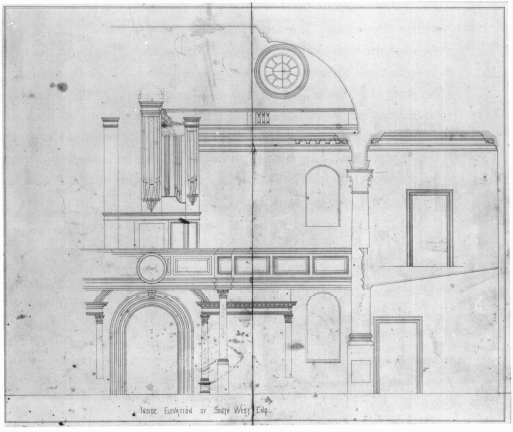
Fig. 363. Elevation drawing showing the Green organ in the southwest interior of the Brattle Square Church, Boston.
In 1798 the First Church Society of Salem voted to purchase an organ. A two-manual, thirteen-stop organ was built in 1799 for the church by John Avery of London, and it was installed in 1800. As it was only the second organ in Salem, and the first in a Congregational church, the process of setting it up drew such a crowd of spectators that the church found it necessary to appoint a committee to keep them from interfering with the work. A description of the organ is found in the manuscript collections of the Essex Institute in Salem:
The organ in the Revd Dr Princes meeting house Salem is of the following dimensions—its height is 7 feet, length 10 and width 5 feet. The case is of pine painted in imitation of mahogany & varnished to immitate mahogany: and it cost in London £341 Sterling, was built by the celebrated John Avery.46
The unknown writer of this description adds elsewhere in his account that “a mahogany case would have been 40 guineas dearer.” Dr. Oliver, in another account from the same manuscript collection, states that Avery was “reputed the first Organ builder for delicacy of tone.”47 This organ was replaced or rebuilt in 1826.
The Green and Avery instruments were the last English organs of any consequence to be imported in the eighteenth century, and among the very few to come from the estranged Mother Country after the Revolution. Already, even in the 1790s, a thin streamlet of American-made organs was beginning to trickle into New England churches, the forerunner of the great river of domestic instruments which would come to flood tide in the middle of the nineteenth century.
Although virtually all of the major organs in the colonies prior to the Revolutionary War were imported, the seeds of a native school of organ building were already sending forth vigorous shoots. Significant activity occurred in Pennsylvania, encouraged by the liturgical traditions of the high concentration of German colonists there. Johann Gottlob Klemm (1690–1762), believed to have once worked for one of the famed Silbermanns in Germany, was building organs as early as the 1740s, including a large one for New York City’s Trinity Church. During the 1760s Philip Feyring, another immigrant, built organs for several important churches in Philadelphia, including two Anglican ones. The still-extant cases of these two latter show them to have been of substantial size. Around this same period David Tannenberg (1728–1804), a Moravian of Lititz, Pennsylvania, and a pupil of Klemm’s, began his significant life work in this field, leaving a considerable output at the time of his death in 1804. He was the most prolific and gifted of this group, and several of his instruments remain in use today. John Dieffenbach (1744–1803), a Schwenkfelder of Reading, Pennsylvania, built his first small organ in the fateful year of 1776. Unlike some of the other regional groups which were slower in taking root, the Pennsylvania school failed to fulfill its promise, and its effective influence may generally be said to have ceased with the death of Tannenberg.
Besides the Pennsylvania builders, there was a small amount of pre-Revolutionary activity in North Carolina, conducted, however, by offshoots of the Pennsylvania Germans. In New York City, one Gilbert (or Gilfert) Ash is supposed to have built an organ around 1756, and a man named Frederick Heyer advertised organs there in 1773, although whether he built or imported them is not known.
Fig. 364. Portrait of Edward Bromfield (1723–1746) of Boston by John Greenwood, Boston, ca. 1745.
Whether William Claggett or any of the other shadowy figures who sold, tuned, and repaired organs in the pre-Revolutionary period in New England actually ever essayed to build an organ is not known. Thus far there has been found no actual record of any of them having done so, but the possibility must always exist. The first person of whom any positive record exists with regard to the building of an organ in New England is Edward Bromfield (1723–1746) of Boston, an amateur (fig. 364). This in itself is no particular cause for surprise; what is unusual is that he was a devout Puritan, a member of the South Church. It has long been known that many well-placed English Puritans, notably the poet Milton, saw no harm in the use of instruments to aid their private devotions; presumably Thomas Brattle was of this same mind. A glimpse into this attitude of the more liberal-minded Puritans toward music is given by the Rev. Thomas Prince, young Bromfield’s pastor, shortly after this promising young man’s untimely death in 1746. Having briefly described Bromfield’s unfinished chamber organ of two manuals and “many hundred” pipes, he states that it was
. . . designed not merely to refresh his spirits but with harmony to mix, enliven and regulate his vocal and delightful songs to his great Creator, Preserver, Benefactor, and Redeemer. He thought the Author of nature and music, does, by his early choristers of the air, with which the day-spring rises, teach us to awake with them, and begin our morning exercises with grateful hymns of joy and praises to him.48
Bromfield, the son of a Boston merchant, was clearly an exceptional person. Entering Harvard College at the age of fifteen, he received his first degree four years later, and his second three years after that. He is described as having been thoughtful and kind, with interests involving nature, mathematics, theology, and the mechanic arts. The organ he began, apparently from knowledge gained solely from the study of the few English instruments then in the city, was left unfinished when he died at the age of only twenty-three. Whether it ever reached the state where it was playable is unknown. It was subsequently either set up or stored in the Old South Church, but there is no record of its ever having been used there during a service of worship, nor is there any record of its having been completed by anyone. In the British siege of Boston during the Revolution the church was seized by British soldiers and used as a stable. The organ was removed and stored elsewhere for safety, but at some point during the war the building in which it had been placed was burned down.
The next person to build an organ in Boston after Bromfield was Thomas Johnston (1708–1767), who is unquestionably the first who could be called a professional organ builder. He too was a Puritan, a member of the liberal Brattle Square congregation, at least as late as 1763, when he was appointed a member of a committee to revise the psalmbook, but he may later have become a member of the then Anglican King’s Chapel, as he was interred in that church’s burying ground.
Thomas Johnston lived all of his life in Boston, and therefore it must be concluded that he was entirely self-trained in matters pertaining to the organ. There is no question that he possessed the necessary manual, mechanical, and artistic skills to learn the art. His primary occupation seems to have been that of engraver, but he is also known to have done painting, wood carving, and japanning. In addition, he was regarded as a good amateur musician. In 1739 he and a Mr. Mason (or Macon) were appointed to lead the singing in the Brattle Square Church, and between 1754 and 1756 he was paid for singing in King’s Chapel. He owned a chamber organ, probably of his own making, and it is assumed that he played it; certainly his son William did, for his proficiency on the organ was such that he served as organist of Christ Church from 1750 to 1753.
Johnston seems to have gotten his start in organ building like many another after him; by tuning and repairing other people’s organs. Between the time of its installation in 1736, and 1743, he tuned and kept in repair Claggett’s organ in Christ Church. In 1743 he made some alterations to it and repitched it a half-tone sharp, and in 1750 he is recorded as having moved some bass pipes in it. Although it is not specifically mentioned in the records of King’s Chapel, it is not unlikely that he occasionally tuned Mr. Brattle’s small organ, and he certainly was familiar with its successor.
Just when he built his first organ is not known. In 1752 Claggett’s organ in Christ Church was in such poor condition that it had to be completely taken down for repairs by Mr. Johnston. In the interval of three months during which this work was carried out he was paid £10 by the church for the use of an organ of his own. Previously, in 1741, he had lent an organ, probably this same one, to Trinity Church, while they awaited arrival of their English instrument. This was obviously a chamber organ, and we can probably assume that he built it himself, although we shall never know for certain. If he did built it, and if it was indeed the same instrument lent to Trinity Church in 1741, then perhaps it is indeed Johnston, not Bromfield, who deserves credit for being the first to build an organ in Boston. In that same year, 1752, he contracted with Christ Church to replace Claggett’s organ, but this project was not carried out until 1758 or 1759. Meanwhile, he is known to have built an organ of one manual and six stops for St. Peter’s Church in Salem, in 1754. In 1770 St. Peter’s acquired a larger organ, from England, and Johnston’s instrument was moved to St. Michael’s Church in Marblehead. In 1832 a new organ was built for St. Michael’s by E. & G. G. Hook, who took the Johnston organ in trade. Its nameboard, reading, “Thomas Johnston Fecit, Boston: Nov-Anglorum, 1754,” was recorded as having been seen by various people in the Hook factory at different times during the nineteenth century; however, it seems to have disappeared when the firm moved to new quarters in 1889.
In 1754 Lewis and Gilbert Deblois built Concert Hall, a Boston musical landmark for nearly a century afterwards, on the corner of Hanover and Queen (now Court) Streets in Boston’s North End, not far from Prince Street, where Thomas Johnston lived. The Deblois family were of Huguenot stock, and were members of King’s Chapel. Lewis, Gilbert, and their father, Stephen, were all organists, one or more of them having served as organist in various churches for nearly a quarter of a century, including Christ Church and King’s Chapel. They carried on a successful importing business on the ground floor of their Concert Hall, and their stock included musical instruments.
When the Concert Hall was opened, or shortly thereafter, it contained an organ by Thomas Johnston. In 1763 Lewis Deblois replaced this organ with a new one by Snetzler imported from London and advertised the Johnston organ for sale (fig. 365). Apparently no Boston church took advantage of this offer, and it was not until 1771 that the organ was sold, through the agency of members of the Deblois family who belonged there, to King’s Church (now St. John’s Church) in Providence. In December of 1772 it was formally consecrated, an act calculated, no doubt, to eradicate all influences of the “Festivity, Merriment, Effeminacy, Luxury, and Midnight Revellings” with which it had presumably been contaminated during its stay in Concert Hall. The music for the occasion was performed by Josiah Flagg of Boston and a small choir, and a sermon was preached “On the Lawfulness, Excellency and Advantage of Instrumental Music in Public Worship.”49
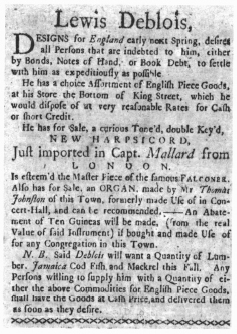
Fig. 365. Advertisement from the Boston Gazette, June 27, 1763.
Since, as has been seen, Providence’s only other church organ, located in the Congregational Church, did not remain in use for long, the Johnston organ in St. John’s soon became well known, especially since the church was often used for public gatherings. In 1791 its use by the church seemed threatened, since it appeared that a loan made by Lewis Deblois to the church at the time of its purchase had never been repaid. The loyalist Deblois family, having been proscribed, was now in London, but through its agents reminded the church of the unpaid loan. The wardens of the church responded, pleading: “We persuade ourselves that your intention is not to distress the Church; having so long experienced the utility of an organ in Divine Worship, we should deeply deplore its loss.”50 Fortunately, the matter was finally settled to everyone’s satisfaction, and the church retained the organ.
The Johnston organ was moved to the church’s new building in 1811 by a local “organ artificer” identified only as Dan Thompson who, according to accounts in the church records, did some releathering and general repairing, made two new front pipes, and set up and tuned the instrument in its new home. It was used again at the consecration of the new building on June 11, 1811, played by the blind Oliver Shaw of the Congregational Church. In 1834 the church purchased a new two-manual organ from Hook. As neither the pipework nor case of the Johnston organ was retained, it must have been taken in trade, sold, or destroyed.
The organ which Johnston built for Christ Church in Boston was almost certainly the largest he ever attempted (fig. 366).51 It had two manuals, but the number of stops is questionable, since the only stoplist of this organ to come down to us was recorded in the early nineteenth century, after the Revolutionary War during which some of its stops seem to have become lost. Its history begins on August 11, 1752 when the vestry of Christ Church
Voted That Mr. Johnson make for the church called Christ Church a New Organ with the Echo equall to that of Trinity Church of this Town, and that he be paid for it two hundred Pounds Lawful Money to be done according to the terms already mentioned & also that Mr. Johnson if he pleases make a Double Diapason in the Trebble.52
It should be remembered that in 1752, when the agreement was drawn up, the Trinity Church organ was the largest in Boston. However, by 1758, when Johnston was actually at work on the Christ Church organ, the newer and larger Richard Bridge organ had been standing in King’s Chapel, where Johnston had been singing, for two years. That he took this for his model, rather than the older Trinity Church organ, is obvious from even the most cursory comparison of the casework of the two organs, which fortunately still exists. Since the Bridge organ then represented the latest and best example of English organ building, there can be little doubt that the Christ Church organ profited from Johnston’s study of it.
Fig. 366. Photograph of case organ by Thomas Johnston, Boston, 1759, in situ in Christ Church (Old North), Boston.
The post-Revolutionary stoplist of Johnston’s magnum opus53 shows no “Double Diapason in the Trebble” (i.e., a 16-foot open diapason beginning at middle C), so it must be assumed either that it never was made, or that it was one of the stops lost during the conflict. Johnston apparently had some difficulty in collecting his full payment for this organ, for the church records show small amounts of money being trickled to him at various times during the year 1759, and in at least one instance church officials had to pay a personal visit to two of the subscribers, who lived in Charlestown, in an effort to collect their pledges. As late as 1764 Johnston petitioned the vestry requesting “some allowance in consideration of the hard bargain he had in makeing the organ,” whereupon they voted to pay Johnston an additional ten pounds, plus three pounds “for half the cost of an additional Stop he has put into the organ.”54 From the church records it would appear that Thomas Stevens and John Longley, probably cabinetmakers, built the case for Johnston’s organ, although the design and embellishments were obviously his.
During the Revolutionary War Christ Church was closed from 1775 to 1778, and the pipework of the organ, along with other items of value, was removed and stored for safety. Although a Huguenot congregation worshiped in the building at some time during its “closed” period, they apparently did not use the organ, and it was not until 1778 or thereafter, when its rightful congregation returned, that the pipes were replaced. A writer of 1834 states that nearly all of the great stops were intact, but that some were lacking in the swell. In this state the Johnston organ remained in regular use until 1808, when most of the old pipes were replaced by William Goodrich. In July of this same year Christ Church’s earliest recorded concert was given, the proceeds of which were to be devoted to the establishment of a singing school as well as the organist’s salary. Three voluntaries were programmed (none, unfortunately, by title), various chants and psalms, and two anthems (“Now Is Christ Risen” and “Ode of Musick”).55
In 1820 the vestry of Christ Church voted to rebuild the organ, and in 1821 William Goodrich provided an entirely new instrument, using only Johnston’s casework, and taking the old interior work in trade. All of this was ultimately discarded with the exception of a wooden stop (probably the 8-foot stopped diapason) which was said to have been incorporated into a one-manual organ built for the Orthodox Congregational Church of Cambridgeport.
The anonymous writer of the invaluable articles in the New-England Magazine for 1834 quotes William Goodrich as having stated that Johnston built two other organs, similar to the Christ Church instrument, for churches in Marblehead (Massachusetts) and Portsmouth (New Hampshire).56 In all probability Goodrich mistook Johnston’s 1754 organ from St. Peter’s Church in Salem as an original installation in the Marblehead church. The Portsmouth church, however, was Queen’s Chapel (now St. John’s Church), later to become the final home of the much-traveled Brattle organ. The first reference to the Johnston organ occurs in a letter from the Rev. Arthur Browne of Queen’s Chapel to the Society for the Propagation of the Gospel in London, from which it can be concluded with some certainty that the idea of purchasing an organ was the church’s and not Browne’s. The letter, dated December 12, 1760, reads in part:
By the state of the case, which will admit of no Contradiction, you may perceive that the Parish is justly indebted to me for House Rent three and twenty years; which Debt, if honestly discharged would extricate me from all my Difficulties, which they are well able to perform having now contracted for the Building of an Organ in Boston at no less a price than 200 pds. Ster: Thus can they exert themselves in matters unnecessary, regardless of weightier ones.57
The Johnston organ remained in use until 1805, when the church and its contents were totally destroyed by fire.
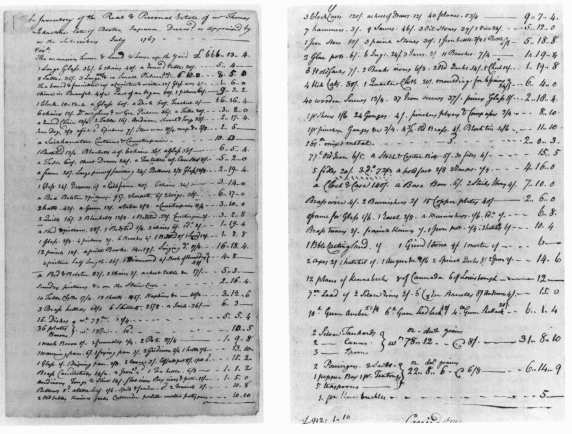
Fig. 367a and b. Two pages from the household inventory of Thomas Johnston, Boston 1767.
Johnston died in 1767, and the inventory of his estate (fig. 367 a and b) included “part of an Organ” (fig. 367a). Whether the latter was a church organ or a chamber organ we do not know, nor do we know of its fate, but it does indicate that Johnston was building organs right up to the time of his death, and that, in addition to those mentioned here, he doubtless built other organs of which no record remains. Along with household items and tools of the engraver’s and japanner’s trade, Johnston’s estate also contained many woodworking and metalworking tools which could have been used in organ building, as well as such specific items as “brass tuners” and a small quantity of block tin, an ingredient of pipe metal. There is no mention in the inventory of Johnston’s own chamber organ. This is thought, however, to have gone to his son-in-law Daniel Rea, Jr., who was an amateur musician and well thought of as a singer.
Various individuals are recorded as having tuned and repaired organs in New England in pre-Revolutionary days, including many of the early organists, some of whom, as a condition of their employment, were required to do their own tuning and maintenance. If we exclude these and the highly questionable Claggett, then the names of those definitely recorded as having actually built organs in this period may be narrowed down to Bromfield and Johnston. And since Bromfield was unquestionably an amateur, Johnston emerges as the one New Englander who may justifiably be called a professional organ builder, despite the fact that this gifted individual combined organ building with several other professions.
Following the Revolution the lessening of trade with England, the liberalizing of the Puritan churches, and a growing national pride in native craftsmanship conspired to give impetus to the growth of organ building in New England. During Johnston’s last years, he made the acquaintance of a young medical doctor, Josiah Leavitt (1743–1804), who showed great interest in organ building and may even have assisted Johnston in his work. Leavitt was but twenty-four years of age when Johnston died. What he did during the period of the Revolution is not known, but the year 1786 finds him as a practicing physician in Sterling, Massachusetts. In this year his early fascination with the organ seems to have caught up with him, for he began building a four-stop chamber organ for his own use. He seems to have had some difficulty with the mechanical part of the work, and engaged Eli Bruce, a twenty-one-year-old mechanic of nearby Templeton, to assist him. Virtually all of the pipes were of wood, for although there is good evidence that Johnston knew how to cast pipe metal and make metal pipes, the process was difficult for an amateur, and required special equipment. Shortly after finishing this organ, Leavitt moved to that part of Massachusetts which is now the state of Maine, and nothing further is heard of him until sometime around 1790, when he is recorded as having repaired the Snetzler organ in Christ Church, Cambridge. This organ had been unusable since the war, most of its metal pipes having been melted down for bullets. Leavitt, again assisted by Bruce, removed the swell and apparently managed to find enough pipes to serve the remaining manual, for the organ, thus repaired, remained in use until 1844, when replaced by George Stevens. This is the first recorded organ work done by Leavitt since having built his own chamber organ, unless Leavitt is the unnamed person who made repairs to the Bridge organ in King’s Chapel in 1788.
While various Boston organists are recorded as having tuned organs in the late eighteenth and early nineteenth centuries, Leavitt seems to have been the first man since Johnston’s death to essay any extensive repairs or rebuilding. Johnston’s son Benjamin, who moved to Newbury around 1770 and worked primarily as an engraver and japanner, is also said to have built organs, but thus far no tangible proof of this has been found. Leavitt’s experience was broadened when, in 1792, he assisted in installing the Green organ in the Brattle Square Church. Shortly after this, Leavitt began building organs of his own in earnest. His first effort seems to have been an “organized harpsichord,” although whether or not he made the harpsichord part is difficult to say, since Leavitt was known at other times to have “organized” existing stringed keyboard instruments, as did Goodrich later on. It was evidently a success, and was glowingly commended, as can be seen from an article which appeared in the Massachusetts Centinel for May 26, 1790 (fig. 368).
William Selby, the organist of King’s Chapel, was an Englishman who, during the late eighteenth century, was perhaps the leading figure in Boston musical circles. A testimonial from him doubtless carried considerable weight. Two other things in this article are worthy of notice. One is the note of national pride on which the account begins; the other is the implication of the widespread use and desirability of keyboard instruments in the home in this period.
In 1792 Leavitt built a small organ for St. Paul’s Episcopal Church in Dedham which, however, seems to have been shortly superseded by a large English chamber organ which had formerly been in the Old Brick Church of Boston. In the same year he became organist of Christ Church, a position he held until 1795. Around 1793 Leavitt built an organ of one manual and seven stops for the Universalist Church on Hanover Street, which was finished in time for the installation of the Rev. John Murray, the founder of Universalism, as pastor on October 24 of that year. Early in the nineteenth century the congregation divided, and the organ was sold at auction to an unknown individual in Vermont.58 Thus it may possibly have been the one-manual organ recorded as having been used in the First Unitarian Church of Burlington from 1817 to 1830.
Fig. 368. Announcement from the Massachusetts Centinel, May 26, 1790.
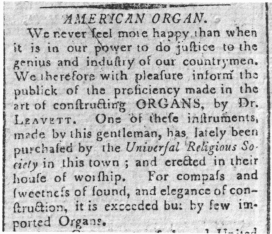
Fig. 369. Announcement from the Columbian Centinel, February 8, 1792.
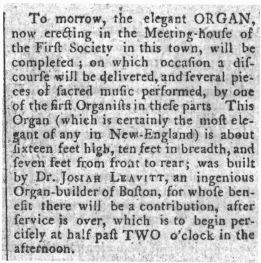
Fig. 370. Description from the [Newburyport] Morning Star, November 5, 1794.
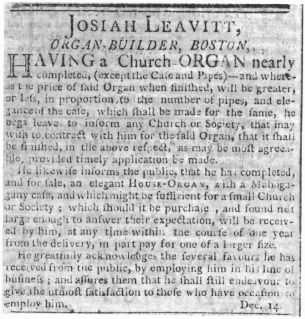
Fig. 371. Advertisement from the Columbian Centinel, December 14, 1793.
Leavitt’s name must have become quickly known among the non-Episcopal churches, for in 1794 he built an organ for the First Religious Society of Newburyport. Although not a large organ, it had a rather oversized case with “Praise Him With Organs” inscribed across the top in gilt letters. This instrument was moved to the Society’s new building in 1801, where it remained until replaced by Joseph Alley in 1834, at which time it is said to have been sold to the Unitarian Church in Eastport, Maine. If this is so, it was replaced by a larger organ in 1855.
Leavitt seems to have had an unusually good press, as figure 369 would indicate. These press notices are important in that they give us a glimpse into the thoughts of Leavitt’s contemporaries, both with regard to their ideals of organ tone and the evident support and encouragement they were then giving to native artistic and musical endeavors—a far cry from the attitudes of three-quarters of a century later, when European music and art were glorified at the expense of native talent. Little wonder, then, at the disparity in originality and output between the two eras.
Leavitt’s organ for the Universal Religious Society of Boston was described in the Columbian Centinel for February 8, 1792 (fig. 369). The Newburyport Morning Star for November 5, 1794 (fig. 370), carried an article on the completion of the organ for the First Religious Society there. Although this latter instrument was a good-sized one-manual instrument of eight stops, the size of the case seems excessively large, and one wonders if Leavitt perhaps had plans to enlarge it at a future date, which were never carried out.
Leavitt also made good use of the medium of advertising. His advertisement from the Columbian Centinel for December 14, 1793 (fig. 371), provides evidence of the practice, to continue well into the latter part of the nineteenth century, of building (or partially building) organs on speculation rather than contract. Interesting also is the knowledge that the “trade-in” principle is hardly a new one, and was probably used to good advantage in fields other than the budding musical instrument business.
Other organs built by Leavitt include one dating from 1792 for the Congregational Church in Worthington (now Berlin), Connecticut, the first in any Connecticut Congregational church, and at least one chamber organ built in this same period for Joseph Hurd of Charlestown.59 The Connecticut organ disappeared when the church constructed a new building in the mid-nineteenth century. Although Leavitt lived until 1804, he is not known to have built any organs other than those recorded here. His name turns up in the records of various churches, however, in connection with repairs to existing organs.
Organ fever seemed to be contagious in the hinterlands of Massachusetts and Eli Bruce, having assisted Leavitt in some of his organ work, commenced to build a four-stop instrument for himself. Although discouraged by friends and relatives, he nonetheless, in good Yankee fashion, finished the organ. It ultimately found its way to the Orthodox Congregational Church of Templeton around 1832, and remained in use there for several years. Just as Bruce had originally become interested in organs through being asked to assist Leavitt, so he in turn hired an assistant, a Mr. Howe of Marlborough, who in turn began to build an organ for himself. This instrument, however, was left unfinished at Howe’s death.60 Unlike Leavitt, who graduated from chamber organs to church organs and made something of a name for himself, Bruce and Howe can be credited with only a single organ apiece. Bruce, however, through his connection with Leavitt, was to play an important part in the encouragement of at least two other embryonic organ builders in his area, both of whom would eventually exceed Leavitt’s output.
The only other builder of any consequence to work in this period, and the only one besides Leavitt to produce any quantity of church organs, was Henry Pratt (1771–1849) of Winchester, New Hampshire. Henry was the son of Noah Pratt, a house joiner from Wrentham, Massachusetts, who also built a number of churches. Henry was born in 1771 and the Pratts moved to Winchester during the 1780s. There are various accounts of how young Pratt first became involved in organ building, although all are agreed that the person who precipitated his taking up this occupation was Capt. Samuel Smith, a wealthy and prominent citizen of Winchester.
The anonymous writer of 1834 in the New-England Magazine states that it was in 1798 that Capt. Smith first approached Pratt to build an organ, which was to be his first. Elsewhere, however, he mentions an organ built by Pratt in 1792,61 so a misprint in one of these dates is suspected. Julius Pratt, Henry’s son, is quoted as saying that Henry, working with his father on a church in Hudson, New York, in the year 1788, obtained the plans of an organ in another Hudson church, and, on returning to Winchester, showed the plans to Capt. Smith. The latter then commissioned young Pratt to build a similar organ, which was completed in 1789.62 In 1933 Maria Pratt Smith, Henry’s granddaughter, recounts the same story in a letter to The American Organist, with but one difference—Boston is given as having been the place where Pratt was working when he obtained the organ plans, and they were those of an English organ.63
From the above it would seem that the New-England Magazine date of 1798 was a misprint, 1789 being intended. This source makes no mention of the organ plans Pratt is supposed to have obtained, but does state that Pratt studied “a very inferior instrument” in the Episcopal Church of Claremont, New Hampshire, made by Dr. Israel Newton of Norwich, Vermont, who is said to have built at least one other organ, and is Vermont’s first recorded organ builder.
Of equal interest is the organ in Hudson or Boston which Pratt also presumably used as a model. After W. J. Bruce’s article appeared, the American Historical Record printed some letters on the subject, one from a Mr. Magoun stating that there was no organ in Hudson until 1811. Probably this 1811 organ was one built by Pratt himself for Christ Church, a fact which may have confused Julius Pratt. Certainly Boston was a more likely place to find an English organ in 1788. Trinity Church, King’s Chapel, and Concert Hall all had good-sized English organs at this time, but one suspects that it was not a church organ but a chamber organ which Pratt chose as his model. Not only would the simpler scope and construction of a chamber organ bring it more within the grasp of a neophyte, but also Pratt’s interests seem to have run in this direction, for much of his subsequent output consisted of this type of instrument, and even his church organs (none of which exceeded one manual) were little more than large chamber organs.
There were, of course, a number of chamber organs of both English and American make in the homes of some of Boston’s more prosperous and musical worthies by 1788, but a house joiner from New Hampshire was not likely to have access to them. However, there was, as early as 1785, a chamber organ of seven stops built by Jonas Ley of London in the Old Brick (First) Church of Boston. Of all the English organs in Boston, this seems the most likely to have been chosen by Pratt as his model. If it was indeed the Ley organ that Pratt studied, it was a happy choice. Not only was it built at a time when the art of building chamber organs was at its apex in England, but it was also of sufficient size to give Pratt information on all of the basic stops. In addition to the usual wooden stopped diapason and metal open diapason and principal pipes, it also had a compound stop (sesquialtera) and a reed stop (hautboy).64
Although Henry Pratt had not built an organ prior to 1788, he was skilled in woodworking, and had made fifes, violins, and clocks. He also repaired guns and watches, certain proof of the mechanical aptitude so necessary for a successful organ builder. After Capt. Smith had commissioned him to build his first instrument, he researched his project with a thoroughness quite extraordinary for a youth of seventeen or eighteen. Besides studying the organs in Claremont and Boston, he also consulted with Eli Bruce, obtaining from him the scales of the wooden pipes he and Leavitt had made. He further supplemented his knowledge from what is described as “an old Dictionary of Arts and Sciences.”65 Could this have been the famous L’Art du Facteur d’Orgues by François Bedos de Celles, which formed a part of Diderot’s encyclopedia of Arts et Metiers? If so, one wonders how and when a copy of this work, first published in 1766, could have found its way into his hands.
Capt. Smith made an agreement with Pratt to give him “. . . a bushel of rye per day while you are building it, and, if you succeed in making an acceptable instrument, I will pay you $300.00 additional.”66 Pratt completed his task a year later, in the summer of 1789. It was a chamber organ of five stops and met with the approval of Capt. Smith, who presented the finished instrument to the Congregational Church. In 1842 it was purchased by the Universalist Church, which used it until 1877, by which time it had fallen into a bad state of disrepair and was superseded by a reed organ. In 1903 it was moved to the Winchester Public Library, where it was restored by the Stuart Organ Company in 1977, and has since been used in several concerts. The stopped diapason, open diapason, and principal are made of old pine, as is much of the mechanism. Even assuming that Pratt was familiar with the process, the casting of pipe metal was probably too difficult a procedure for a novice to attempt, so the twelfth and fifteenth stops are made from the thin sheet lead that was used as a waterproof lining in tea chests shipped from England. Pratt was probably not the first or last to utilize this handy source of ready-made pipe metal; there is evidence that Leavitt and Bruce used this material also.67
Pratt was apparently in little haste to become an organ builder, for he is not recorded as having built another instrument (apparently a small chamber organ for his own use) until 1792. In 1799 he was commissioned by George Holbrook, the bellfounder, to build an organ, which was then sold by Holbrook to the Congregational Church in Pittsfield. In 1801 Capt. Smith ordered another organ, which on completion he presented to the First Parish in Northfield, Massachusetts. From this time until his death in 1849, Henry Pratt seems to have been engaged full time in organ building. By 1834 he had already built twenty-three one-manual organs of from four to six stops for country churches, as well as nineteen chamber organs of smaller size. Of these at least three are still in existence,68 and possibly more, since positive identification of his work (which he never signed) is difficult.
Henry Pratt has particular historical significance for two reasons. One is that he began building organs for small rural Congregational churches at a time when the Puritan prejudice against instrumental music was far from dead; indeed, his contributions may have helped to hasten the death-blow which dispatched this prejudice within his own lifetime. His work is also important in that it was part of an ongoing tradition, providing the link between Johnston, Leavitt, and William Goodrich. Leavitt, it will be recalled, often visited Johnston’s workshop as a young man, laying the foundations for what, some years after Johnston’s death, became a full time career as an organ builder. Although Leavitt died in 1804, he probably knew Pratt, and there is in any case the recorded connection between the two through Eli Bruce, who, while not primarily an organ builder, worked for both builders, and provided Pratt with some of Leavitt’s pipe scales. In 1800 William Goodrich of Templeton, Massachusetts, then a young man of twenty-three, spent eight months working for Pratt while the latter was engaged in building the organ for the Northfield church. After Goodrich moved to Boston, he kept in touch with Pratt, and “each made known to the other all the knowledge, discoveries, inventions, and improvements, of which they became possessed.”69 One can perceive many reasons for this friendship. The two men were but six years apart in their ages, and they shared the endowment of an inventive, inquiring, and restless intellect. The result of this was often blind alleys entered out of curiosity, such as Pratt’s invention of a wood pipe open at both ends and intended to simulate the German flute—a clever idea but impossible of execution since no way could be found conveniently to plant such pipes on a windchest.
Henry Pratt’s career actually spanned two periods in the development of New England organ building. His importance, however, stems from his early work in the post-Revolutionary period. Although he worked continuously during the important period following the War of 1812, he was greatly overshadowed by William and Ebenezer Goodrich, Thomas Appleton, and the Hooks, for whose work, in many ways, he helped prepare the way.
The period prior to 1812 saw the emergence of a number of other small organ builders, mostly part time, and largely outside the mainstream of the growing Boston tradition. Few of these builders had an output even approaching that of Leavitt or Pratt in this period, with the possible exception of George Catlin (1778–1852) of Hartford, Connecticut, who built two or more church organs in the period between 1800 and 1812, and advertised that he made chamber organs and pianos as well.70 Of the rest, most are known for having built a single church organ, and many built no more than a chamber organ or two. Still, there was a rather surprisingly large number of these semi-amateur organ builders at work in this period, in itself an indication of the growing interest in the art that was to flower so abundantly in New England during the nineteenth and twentieth centuries.
Church and Concert Hall Organs in New England in the Eighteenth Century
| Date | Location | Maker | |
|---|---|---|---|
|
1713 |
Boston, Mass. |
King’s Chapel |
unknown, English (chamber organ imported prior to 1708 by Thomas Brattle) |
|
1733 |
Newport, R.I. |
Trinity Church |
Richard Bridge |
|
1736 |
Boston, Mass. |
Christ Church |
unknown (either William Claggett or English) |
|
1743 |
Salem, Mass. |
St. Peter’s Church |
unknown, English |
|
1744 |
Boston, Mass. |
Trinity Church |
Abraham Jordan |
|
1745 |
Boston, Mass. |
Old South Church |
Edward Bromfield, Jr. (never finished and never used in a church service) |
|
1754 |
Salem, Mass. |
St. Peter’s Church |
Thomas Johnston |
|
1754 |
Marblehead, Mass. |
St. Michael’s Church |
unknown, English (secondhand from St. Peter’s in Salem) |
|
?1755 |
Boston, Mass. |
Deblois Concert Hall |
Thomas Johnston |
|
1756 |
Boston, Mass. |
King’s Chapel |
Richard Bridge |
|
1756 |
Newburyport, Mass. |
St. Paul’s Church |
unknown, English (secondhand from King’s Chapel, Boston) |
|
1756 |
Stratford, Conn. |
Christ Church |
unknown, English |
|
1759 |
Boston, Mass. |
Christ Church |
Thomas Johnston |
|
1760 |
Portsmouth, N.H. |
St. John’s Church (formerly Queen’s Chapel) |
Thomas Johnston |
|
1760 |
Middletown, Conn. |
Trinity Church (formerly Christ Church) |
unknown, English |
|
1762 |
Original location unknown (possibly Boston or Providence): since 1858 in Congregational Church, South Dennis, Mass. |
John Snetzler |
|
|
Boston, Mass. |
Deblois Concert Hall |
John Snetzler |
|
|
1764 |
Cambridge, Mass. |
Christ Church |
John Snetzler |
|
1768 |
Marblehead, Mass. |
St. Michael’s Church |
Thomas Johnston (secondhand from St. Peter’s, Salem) |
|
1770 |
Salem, Mass. |
St. Peter’s Church |
unknown, probably English |
|
1770 |
Providence, R.I. |
Congregational Church |
unknown (a chamber organ belonging to Jonathan Badger) |
|
1772 |
Providence, R.I. |
St. John’s Church (formerly King’s Church) |
Thomas Johnston (secondhand from Deblois Concert Hall) |
|
1785 |
Boston, Mass. |
First Church (“Old Brick”) |
Jonas Ley |
|
1785 |
New Haven, Conn. |
Trinity Church |
Henry Holland |
|
1789 |
Winchester, N.H. |
Congregational Church |
Henry Pratt |
|
1790 |
Boston, Mass. |
Brattle Square Church |
Samuel Green |
|
1791 |
Norwich, Conn. |
Christ Church |
unknown, probably English |
|
1792 |
Berlin, Conn. (formerly Worthington) |
Congregational Church |
Josiah Leavitt |
|
1792 |
Dedham, Mass. |
St. Paul’s Church |
Josiah Leavitt |
|
1793 |
Boston, Mass. |
Universalist Church |
Josiah Leavitt |
|
1794 |
Charlestown, Mass. |
First Church |
unknown |
|
1794 |
Newburyport, Mass. |
First Religious Society |
Josiah Leavitt |
|
?1795 |
Boston, Mass. |
New South Church |
unknown, English (chamber organ purchased from Nathan Frazier) |
|
1798 |
Portland, Me. |
Second Church |
unknown |
|
?1799 |
Boston, Mass. |
Columbian Museum |
unknown |
|
1799 |
Pittsfield, Mass. |
First Church |
Henry Pratt |
|
1800 |
Salem, Mass. |
First Church |
John Avery |
|
1801 |
Northfield, Mass. |
First Parish |
Henry Pratt |
|
1803 |
Providence, R.I. |
First Church |
John Geib |
selective bibliography
Along with the specific references cited in the footnotes, certain important general sources have been drawn upon to provide material for this article.
Henry M. Brooks, Olden-Time Music (Boston, 1888).
Talmage W. Dean, “The Organ in Eighteenth Century English Colonial America” (University of Southern California, Ph.D. diss., 1960).
Leonard Ellinwood, A History of American Church Music (New York, 1953).
John T. Fesperman, A Snetzler Chamber Organ of 1761 (Washington: U.S. Government Pamphlet, 1970).
Sinclair Hitchings, “Thomas Johnston,” Boston Prints and Printmakers 1670—1775, Colonial Society of Massachusetts, Publications, xlvi (1973).
Joyce Ellen Mangier, “Music in King’s Church, Providence,” Rhode Island History, xvii (July 1958).
Robert J. Reich, “An Historical Organ at Schuylerville, N.Y.,” The Tracker, v (January 1961).
Eliot I. Wirling, “Pipe Organs of New England,” Old-Time New England (Fall 1954).

 BARBARA OWEN
BARBARA OWEN
